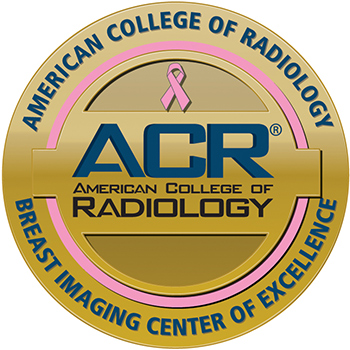A Leader in Breast Cancer Treatment
Breast cancer is the second most common cancer in women and can affect one in eight women over their lifetime, according to the American Cancer Society®. Men are not immune from breast cancer either; an estimated one in 833 men will develop breast cancer during their lifetime.
Breast cancer is the growth of abnormal cells in breast tissue that results in a mass or tumor. Not all tumors are cancerous or life threatening. Tumors that are cancerous are called malignant, while tumors that are not cancerous are considered benign. When malignant cells move to other parts of the body, or invade surrounding healthy tissues, the original tumor is said to have metastasized or spread to other parts of the body.
Breast Imaging Center of Excellence
 As an accredited breast cancer program, Wellington Regional Medical Center (WRMC) has been recognized nationally as a leader in breast imaging and the treatment of breast cancer. As an American College of Radiology (ACR) Breast Imaging Center of Excellence, WRMC has demonstrated excellence in mammography, breast ultrasound and MRI of the breast, as well as stereotactic, ultrasound and MRI guided breast biopsies.
As an accredited breast cancer program, Wellington Regional Medical Center (WRMC) has been recognized nationally as a leader in breast imaging and the treatment of breast cancer. As an American College of Radiology (ACR) Breast Imaging Center of Excellence, WRMC has demonstrated excellence in mammography, breast ultrasound and MRI of the breast, as well as stereotactic, ultrasound and MRI guided breast biopsies.
Schedule an Appointment
For more information or to schedule an appointment, please contact the Advanced Breast Center at Wellington Regional at 561-798-8513.
Diagnosis and Detection of Breast Cancer
3D Mammography
 Wellington Regional offers the Genius® 3D Mammography™ exam. This exam provides better, earlier breast cancer detection compared to 2D mammography alone. Greater accuracy means earlier breast cancer detection and earlier intervention. The Genius exam is proven to:1
Wellington Regional offers the Genius® 3D Mammography™ exam. This exam provides better, earlier breast cancer detection compared to 2D mammography alone. Greater accuracy means earlier breast cancer detection and earlier intervention. The Genius exam is proven to:1
- Provide better, earlier breast cancer detection
- Reduce unnecessary need to return for additional imaging studies
- Find more invasive cancers than conventional mammography alone
The Genius exam enables doctors to examine your breast tissue layer by layer. Instead of viewing all the complexities of your breast tissue in a flat image, fine details are more visible through the Genius 3D mammography and are no longer hidden by the tissue above or below the target area, as they are with conventional 2D mammography.
The process of a Genius exam is the same as a conventional 2D exam. The 3D exam requires no additional compressions and only takes a few extra seconds. The Genius exam is more accurate for women of all ages, with both dense and non-dense breasts.
Stereotactic Biopsy
For abnormal findings seen by mammography, stereotactic core biopsy is an alternative and preferred method to the traditional surgical biopsy. It is less invasive, with a quicker recovery time and no significant scarring.2 The procedure uses several X-rays (stereo images of the same area from different angles) to confirm the exact location of the tissue for the minimally invasive removal of small core samples of the tissue for the biopsy.
Breast Ultrasound
Ultrasound of the breast is a procedure that is comfortable and cost-effective. It helps doctors see breast changes that may not be felt or seen by mammography. It may be useful in seeing changes in dense breast tissue that may not be apparent by mammography. Ultrasound can be used to tell the difference between fluid-filled cysts and solid masses.
Ultrasound Guided Breast Biopsy
Ultrasound may be useful during the guidance of minimally invasive procedures, such as needle biopsies. Ultrasound helps the doctor guide the needle into the precise area to be biopsied, removing cells or tissue to be tested. The samples are sent to a pathologist for review under a microscope. Most biopsy results are not cancerous and therefore not life-threatening.
Breast MRI
MRI of the breast is a tool that goes above and beyond conventional imaging. It can provide solutions to difficult diagnostic problems and may identify tumors that other examinations may fail to detect. MRI is usually performed when your doctor needs additional information regarding a mammogram or ultrasound. It can also address clinical problems not solved by conventional imaging.
Breast MRI has a number of different uses, including:
- High-risk screening.
- Gathering more information about a suspicious area seen by mammography or ultrasound.
- Detecting other areas of cancer if present after a recent diagnosis of breast cancer.
- Unlike many other imaging centers, Wellington Regional Medical Center has the capability to perform minimally invasive biopsies under MRI guidance, which sometimes is necessary for certain abnormalities.
Intraoperative Specimen Radiography
Wellington Regional operating rooms are equipped with portable imaging units which enable surgeons to image the specimens immediately upon removal from the breast. This provides real-time confirmation of successful removal of the intended tissue as well as information regarding adequacy of the margins.
Breast Cancer Treatment Options
Surgeons at Wellington Regional perform the full spectrum of breast cancer surgery. Surgical options typically include breast conservation (lumpectomy) and mastectomy (removal of all breast tissue).
Savi SCOUT®
 For non-palpable cancers, Wellington Regional offers the Savi SCOUT® wire-free radar localization system, which helps physicians precisely locate tumors during a surgical procedure. It increases the probability of complete cancer removal while conserving healthy breast tissue.
For non-palpable cancers, Wellington Regional offers the Savi SCOUT® wire-free radar localization system, which helps physicians precisely locate tumors during a surgical procedure. It increases the probability of complete cancer removal while conserving healthy breast tissue.
Many women diagnosed with breast cancer are opting to have breast conservation treatment (BCT) in place of a mastectomy. Instead of traditional wire localization techniques for surgical guidance where a wire can remain outside of the breast to help the physician locate the tumor, the Savi SCOUT system uses a tiny reflector (about the size of a grain of rice) that is placed inside the tumor prior to surgery. The reflector is then located by the surgeon with non-radioactive radar to provide real-time guidance during surgery for tumor removal.
Finally, the system confirms that the reflector has been removed along with the targeted tissue. The Savi SCOUT system can lead to a more seamless patient experience on the day of the surgery.
Interoperative Radiation Therapy
For breast cancer patients who meet the criteria, Interoperative Radiation Therapy (IORT) offers a possible one-time radiation treatment option, delivered while patients are asleep in the operating room at the time of their lumpectomy. With IORT, radiation oncologists, pathologists and breast surgeons collaborate to deliver a concentrated one-time dose of radiation which targets the cancer cells without damaging healthy tissues surrounding the area. This one-time treatment option may prevent the need for longer courses of radiation therapy.
Nipple Sparing Mastectomy
Nipple sparing mastectomy is the removal of the cancerous breast tissue without removing the nipple or areola. For the patients who meet the criteria, nipple-sparing mastectomies allow for reconstruction of the breast with results that are similar to the natural breast with minimal visible scarring. The long-term prognosis using the nipple sparing technique to treat breast cancer is excellent.
Hidden Scar Surgery
Hidden scar breast cancer surgery uses surgical techniques where the scar is hidden in natural skin folds such as the armpit, crease under the breast or around the areola, and are not visible once healed. The technique can be used in both nipple sparing mastectomies as well as lumpectomies.
Candidates for hidden scar surgery include patients with:
- Small tumors compared to breast size
- Cancer that has not spread to the nipple area
- Tumors that are small enough to completely remove while non-diseased tissue remains around the tumor
- Tumors that are located in one area of the breast
Dedicated Breast Cancer Navigator
Confronting a breast cancer diagnosis can be an overwhelming and emotional time, but you do not have to face it alone. At Wellington Regional Medical Center, our goal is to help breast cancer patients feel more comfortable and confident throughout the treatment process.
Our nurse navigator accompanies the patient every step of the way to provide support and serve as a personal advocate throughout the journey. We know a diagnosis of breast cancer can be difficult and often confusing, and our nurse navigator can help patients make the complicated more understandable, the overwhelming more manageable, and place the patient at the center of the patient care experience.
2 Individual results may vary. There are risks associated with any surgical procedure. Talk with your doctor about these risks to find out if minimally invasive surgery is right for you.
